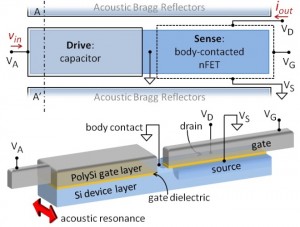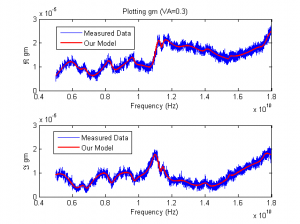Compact Parameterized Modeling of RF Nano-Electro-Mechanical (NEM) Resonators
- Category: MEMS & BioMEMS
- Tags: dana weinstein, luca daniel, radhika marathe, zohaib mahmood
Design and optimization of novel RF Nano-Electro-Mechanical (NEM) resonators such as Resonant Body Transistors (RBT) require modeling across multiple domains, including mechanical (distributed stress and elastic wave models), electrical (semiconductor devices and RF small signal models), and thermal. These domains are all cross-coupled in nonlinear ways and require lengthy finite element multi-physics analyses to solve. Due to the complexity of these structures embedded in the CMOS stack and sensed using active FETs, the day-long time scale of each finite element simulation prevents quick, intuitive parameterization of device design. A reduced model parameterized across all three domains is therefore necessary both for rapid prototyping and for device optimization.
In this work, we are developing an algorithm to automatically generate compact models for NEM resonators. Our compact models are suitable for AC, DC and RF operation of the device and allow the circuit designers to run circuit-level time-domain simulations using any commercial circuit simulator [1] [2] . The compact models are “parameterized,” so that the circuit designer will be able to instantiate instantaneously models within the circuit simulator for different values of the key device parameters. Key resonator parameters included in the compact parameterized model are resonant frequency, quality factor, signal strength, isolation, presence of spurious modes, and operating temperature. Values for the model coefficients are calibrated using measurements from NEMS resonator devices. A critically important feature of our models is to guarantee that when circuit designers change arbitrarily values for the device parameters, the compact models will always preserve the physical properties of the original device and will never cause numerical instabilities and convergence issues when connected to other device models and circuits within the circuit simulator [3] . Figure 1 shows the layout of a Si-based NEMS-CMOS resonator. Numerical results show a great promise for our technique. We have achieved high quality fit to the measured data, as Figure 2 shows, which offered modeling challenges including the presence of noise and spurious resonant peaks.
- Figure 1: Top and 3D views of a Si-based NEMS-CMOS.
- Figure 2: Plotting measured data (blue noisy line) and the output from out model (red smooth line) for controlling voltage VA=0.3V.
- Z. Mahmood and L. Daniel, “Circuit synthesizable guaranteed passive modeling for multiport structures,” in Proc. of Behavioral Modeling and Simulation Conference (BMAS), Sept. 2010. [↩]
- Z. Mahmood, R. Suaya and L. Daniel, “An efficient framework for passive compact dynamical modeling of multiport linear systems,” in Proc. of Design, Automation and Test in Europe, (DATE), Mar. 2012. [↩]
- Z. Mahmood and L. Daniel, “Guaranteed passive parameterized modeling of multiport passive circuit blocks,” in Proc. of TECHCON, Sept. 2011. [↩]

